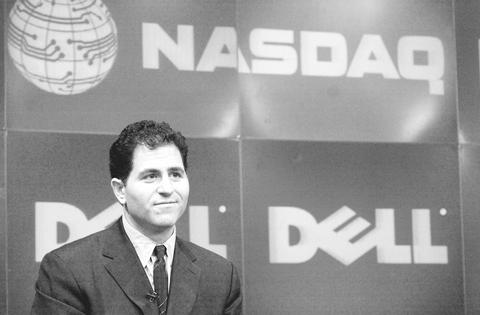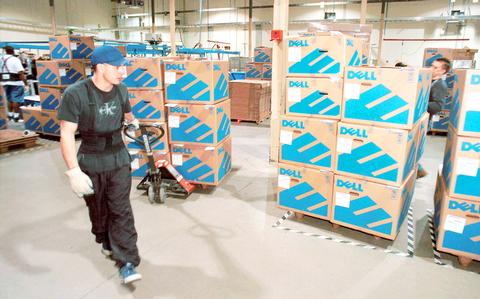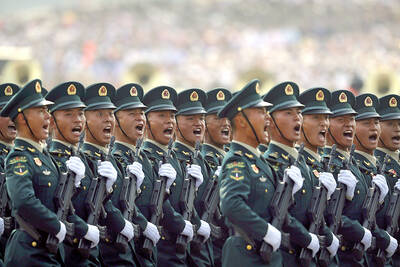"There weren't too many people interested in going," says Matter, 52, a high school wrestling coach who bought Dell shares in 1996 and has recommended the stock to former students. "It's been rough the last year." After a run as the best-performing stock of the 1990s, Dell shares plunged 66 percent in 2000, their worst showing since the PC maker went public in 1988. They're still 62 percent below their high, closing at US$22.32 yesterday, even after the company said that fiscal third-quarter sales and earnings will meet predictions.
Dell has cut profit or sales forecasts seven times since January of last year and missed them once. In August, it reported a US$101 million loss, only its second quarterly deficit and the first since 1993.

PHOTO: BLOOMBERG
Just as Dell passed Compaq Computer Corp for the first time in worldwide PC sales, Hewlett-Packard Co swooped in. On Sept. 4, the Palo Alto, California, computer maker headed by CEO Carly Fiorina agreed to buy Compaq in a deal now valued at US$17.3 billion in stock.
The combined company would take back the title of No. 1 PC maker based on second-quarter data compiled by market researcher IDC. Dell shipped 3.98 million PCs during the period, while Hewlett-Packard and Compaq jointly shipped 5.66 million.
Trouble is, the PC market is in its worst slump since monitor screens were green on black. Second-quarter sales industry wide fell for the first time in 15 years. IDC had predicted that third-quarter sales would rise slightly from the second quarter.

PHOTO: BLOOMBERG
Now, the terrorist attacks in New York and Washington will cause shipments to fall in the third quarter and to decline more than expected for the year, IDC says. Chief Executive Michael Dell, 36, doesn't see a rebound until at least the middle of next year.
Recession strategy
Dell, seated in a sparse conference room that belies his company's US$58 billion market value, says he has a plan to skirt the slowdown. He's adapting the build-to-order, buy-on-the- Internet strategy that anchors his PC business to the more profitable business of building servers, the computers that run networks, databases and Web sites.
PC margins have slipped to less than 10 percent in the past year, while margins on some of the biggest servers can be as high as 40 percent, according to IDC.
He's having some success. In the second quarter, Dell tied Compaq as the biggest US server seller, with 29 percent of the market. Dell's server sales rose 15 percent, while Compaq's fell 26 percent. Worldwide, Dell has grabbed 18 percent market share -- up from nothing five years ago, when Dell built only PCs.
"There's no reason why we can't grow to 25 or 35 percent market share," Michael Dell says of his server strategy. "The opportunity's there." Rivals Compaq, IBM and Sun Microsystems Inc say there are plenty of reasons it won't be easy for Dell. First, a bulked-up Hewlett-Packard would take the US server crown back from Dell. Combined second-quarter server shipments by Hewlett-Packard and Compaq were 125,738, outpacing Dell's 99,000, according to Gartner Inc's Dataquest unit.
While size isn't everything, analysts say that if Hewlett-Packard succeeds in digesting Compaq, the new company will be stronger in servers as well as in computer services, an area in which Dell relies on partners such as Electronic Data Systems Corp.
"They'll be able to bundle their hardware and sell it with their services," says Christian Koch, senior technology analyst at Trusco Capital, which sold its 4.5 million Dell shares in June. "That's something Dell isn't able to offer." To change itself as a company that makes comprehensive computer systems -- from desktops to servers, storage and the switches that connect them -- Dell must convince customers it's more than a "box maker" by showing it can build and support complicated systems.
"When somebody has a really complex problem, the first people they think of is IBM," says Rich Partridge, a senior research analyst at D. H. Brown & Associates. "I don't think Dell's going to break into that area." To gain market share, Michael Dell will have to keep a combined Hewlett-Packard and Compaq at bay in low-end servers that sell for less than US$25,000. At the other extreme, he'll face Sun, which not only makes US$1 million servers geared to customers who can't afford crashes but also has thousands of technicians to design systems around customer needs.
Ranks thinning
Dell, who built his company by seeking out experienced executives, will be waging the battle without key lieutenants.
Chief Financial Officer Tom Meredith, 51, stepped aside in March 2000 to run Dell's venture capital arm and then retired in August this year.
Meredith, who joined Dell in 1993, focused on the financial benefits of direct sales, resulting in a sevenfold sales increase and average annual profit growth of 265 percent from 1994 to 1999.
Mort Topfer, 64, retired as vice chairman in December 1999, although he's still a director and an adviser to Michael Dell. The former Motorola Inc executive brought expertise in strategic planning and spearheaded Dell's international expansion.
"Those two guys really turned a small company into something that makes Compaq quake in its boots," says John Zappa, a former manager in Dell's finance department.
In late August, Topfer's replacement, former IBM executive James Vanderslice, 60, said he would retire next year.
Meanwhile, Dell's main PC business -- which generated 81 percent of the company's US$31.9 billion in revenue in the fiscal year ended in January -- is struggling.
Even though Dell still makes money from PCs, lower prices and weak demand will keep its stock depressed for at least 18 months, says Brett Miller, an analyst at A. G. Edwards Inc, who has a "maintain position" rating on the shares. The company must sell two PCs for every one it sold in 1997 to generate the same revenue.
Gains in server sales aren't enough to rid Dell of its PC dependency, Miller says. "PCs are still an anchor around their neck." Miller says he'd wait to buy. "In two years, I'd buy Dell, but I'd be buying it for the same price I'd buy it at today." Michael Dell, charging out of a board meeting at the executive offices in the limestone hills of South Austin, Texas, grins broadly at such predictions. He's reminded of the summer of 1984, after he dropped out of the University of Texas to build computers under the name PC's Limited.
People told him he couldn't compete against Compaq and IBM, even though as a 19-year-old, he was selling US$80,000 of PCs every month from his college dorm room and making more money than most professors made in a year.
They said the same when he gave up on retail sales and decided to sell all of his machines directly to customers. They said it in 1993, when his company stumbled in its attempt to design notebook computers, and in 1996, when he began building servers.
"It's been the greatest thing ever for us to have naysayers," says Dell, wearing an open-collared blue dress shirt and black pants, his eyes darting as he talks. "Our competitors said, `No, this isn't going to work.' What a wonderful thing that was." Now, critics such as Trusco's Koch say Dell can't compete against Sun or Compaq and Hewlett-Packard either individually or as a merged company -- because it doesn't have a services arm to sell the biggest and most profitable servers.
A services business advises customers on what machines to buy, what software to use and how to set up equipment. IBM, for one, pitches services as a key selling point.
Michael Dell aims to bring to servers the manufacturing and distribution innovations he introduced with PCs. The entrepreneur built his company around a simple idea: Assemble parts into PCs more efficiently than competitors, and sell the machines directly to customers.
At the time, the industry used resellers -- middlemen who worked as brokers between manufacturers and customers. The resellers set up a PC with software, tested it and helped a customer install the machine, marking up the price along the way.
Dell realized he could bypass resellers and configure the PCs himself. It's something Dell factories in Round Rock, Texas; Limerick, Ireland; Eldorado do Sul, Brazil; and Xiamen, China, still do. The plants crank out as many as 30,000 machines a day.
Half of Dell's sales, or about US$43 million a day, are handled via its Internet system and Web sites, making it one of the largest e-commerce companies -- a fact Dell uses in pitches for its servers.
Dell's manufacturing and sales method -- known among employees as "the model" -- let it sell consumer desktops with a 900MHz Intel Corp Celeron processor starting at US$579 in mid-September. Gateway Inc, the No. 2 direct seller, offered a PC with a 950MHz Celeron chip for US$684.
Dell hopes to create the same price gaps in servers. The server market is divided into two camps: machines powered by Intel processors that use Microsoft Corp's Windows operating system and those, such as Sun, whose chips run Unix.
Spurred demand
Intel systems are generally cheaper, and Dell is squarely in that camp, as it is with PCs. Dell began making servers in 1996, relying on an Intel design. The Internet boom spurred demand because such servers were easier to use.
Unix loyalists argue that Intel chips aren't powerful enough and Windows isn't reliable for tasks such as running large databases.
Melding the two sides was part of Hewlett-Packard's strategy in agreeing to buy Compaq, Fiorina said at a conference sponsored by SG Cowen & Co in September. Compaq's strength lies in Intel-based machines, while Hewlett-Packard's is in Unix.
"These companies fit like a zipper," she says.
Dell lacks a presence on the Unix side, which competitors argue will impede growth in servers. Unlike PC customers, those who buy servers usually don't know what they need, and want advice.
"In the server game, it's about systems delivery; it isn't just about price," says Stephen DeWitt, head of Sun's Cobalt division, which makes low-cost servers that compete with Dell. "I don't see a path for Dell to compete." Services also played a role in Hewlett-Packard's decision to buy Compaq. With more than 20,000 technicians and consultants, the combined company would be able to tout its design capabilities.
"They clearly want to morph into a services gorilla," says Bruce Garelick, an analyst at Loomis Sayles & Co, which owned 362,000 Hewlett-Packard and 1.95 million Compaq shares as of June 30.
For now, Dell is content to attack the lower end of the server market by selling its machines more cheaply. A Dell server with eight 700MHz Intel Xeon processors costs as much as US$92,000 on Dell's Web site. A comparable Sun machine with six 464MHz UltraSPARC-II processors runs as much as US$157,000.
David Kauffman, director of communication technology at Dallas-based Baylor Health Systems, one of the largest US not- for-profit health care systems, says he spends about US$10,000 for each Dell server he buys. Before switching to Dell in January, he had paid about US$28,000 for comparable machines from Compaq.
Dell typically ships servers to him in five days. Compaq took as long as 37 days and then required resellers to set up the machines, load the software and test it, he says. "When we get them from Dell, we take them out of the box and they work," he says.
Compaq is fighting back. It's shortened delivery to 10 days, and its server shipments rose by more than 15,000 from the first quarter to the second, while Dell's rose by 4,300, according to Dataquest. That's because unlike Kauffman, many buyers don't want to simply plug in boxes, says Compaq Senior Vice President Mary McDowell.
Even so, customers like Kauffman helped boost Dell's server and storage sales to 19 percent of its worldwide revenue last year, up from 17 percent a year earlier. That number inched up to 20 percent, or about US$3 billion, for the first half of this year, making Dell the second-biggest server maker, behind Compaq, as well as tying Compaq in the US.
"We're seeing a huge swing by the customers themselves voting for our approach," says Russell Holt, vice president of Dell's server and storage division.
Allscripts Healthcare Solutions Inc swung the other way.
It agreed in March to buy US$100 million of machines from Compaq, replacing its Dell servers. Allscripts wanted to use a wireless network to link servers to handheld devices doctors use for storing medical information.
Unreliable
Jim Hewitt, Allscripts chief information officer, says the Dell machines weren't as reliable. In some cases, newer machines weren't compatible with older versions, and Dell's focus was on price rather than dependability. "It's more just a mail-order-type thing," Hewitt says. "It's a high-volume business, and that's all they care about." Competitors argue that Allscripts and customers like it prove Dell will never turn servers into a commodity the way it did with PCs.
"People depend on servers for higher-level applications," says Compaq's McDowell. "Complexity favors companies with strong engineering." Dell has never been a big spender when it comes to developing products. Last year, it spent US$482 million, or 1.5 percent of sales, on research and development. Compaq spent three times as much -- US$1.47 billion -- and Sun typically spends more in one quarter than Dell does annually. Hewlett-Packard spent US$2.6 billion, or 5.4 percent of sales, for its fiscal year ended Oct. 31, this year.
"Dell is not an innovator; they're a distributor," says Jim Gargan, IBM's vice president of Intel-based servers. "They have to wait for someone else to innovate." Dell's Holt argues that his company doesn't have to spend on research and development, because unlike Sun and Compaq, it uses standard parts. "Dell doesn't necessarily have to be the sole investor," he says. "We're able to leverage Microsoft's investment, and we're able to leverage Intel's investment." Michael Dell sees rivals' attacks as more naysaying. He says that new chips from Intel, such as the Itanium, and new versions of Windows are making his machines more reliable. As that happens, customers won't pay top dollar for Unix, and Windows will overtake it.
Dell says he doesn't need to bulk up on services, either.
Instead, he's teaming up with such companies as EDS and Computer Sciences Corp.
EDS says it jumped at the chance to work with Dell, because Dell is one of the few hardware makers that doesn't compete with it in services. IBM unseated EDS as the biggest computer services company in 1995, and Compaq began its push into services in 1998, when it bought Digital Equipment Corp.
"They put themselves into a position where we can never be as tightly aligned with them"' says John Wilkerson, EDS's president of global alliances.
Dell offers EDS incentives -- typically, reduced prices on its machines -- to push Dell products to customers, Wilkerson says. In return, EDS gets Dell into computing contracts it couldn't have bid on otherwise. In October, for example, EDS landed an eight-year contract worth almost US$7 billion to build and run a computer network for the US Navy by using mostly Dell hardware.
Rivals vulnerable
Joel Kocher, Dell's president of worldwide sales and marketing from 1987 to 1994, says rivals such as Compaq and Hewlett-Packard are as vulnerable to Dell in servers as they were in PCs.
Kocher gave up on PCs after trying for three years as head of Micron Electronics Inc to compete against Dell. In March, Micron, then the No. 3 direct seller, said it planned to sell its PC operations and instead manage Internet sites. It changed its name to Interland Inc in August.
"They've convinced themselves that Dell can't beat them in servers, but that's exactly what's happening," Kocher says.
"Dell's doing the same thing to Compaq and HP with servers that they did to them in notebooks, which is the same thing they did in desktops." While he's slugging it out in the server business, Michael Dell can't afford to take his eyes off PCs. He made that mistake last year. In the third quarter of 2000, Dell's share of the US PC market slipped slightly -- to 19.7 percent from 20.1 percent in the second quarter, according to IDC.
At the same time, Compaq's share rose to 17.3 percent from 14.8 percent. Dell admits he got distracted by the hot market for servers to run Web sites and didn't keep a close watch on rivals' PC prices.
"There were a couple of things that got out of whack," Dell says. "For a brief time, it looked like our competitors had recovered a bit, but it was really more our failure." By the fourth quarter, Dell had battled back, cutting prices to woo customers even as PC demand slowed. For Dell, the slumping PC market had its advantages. The company reduced prices in January, meaning, competitors had to cut too, at a time when fewer people were buying PCs.
The strategy exacerbated rivals' losses. In the second quarter, Compaq reported a US$279 million loss. Compaq said this week that it expects a third-quarter loss from operations of US$0.05 to US$0.07 a share excluding a US$500 million charge for investment losses. Most analysts had predicted that Compaq would earn US$0.05, according to First Call.
Unlike Compaq, Dell can make money by selling a PC for US$579 because it forces costs back on suppliers. At its factory in Austin, Dell builds a server in about 10 hours, just four hours more than it takes to build the average PC.
At its newest Austin operation, it builds OptiPlex desktops for corporate customers by using the same process it uses for servers. The plant, called Parmer North Two, is a prototype for factories in Brazil and China, which can be adapted to either PCs or servers, based on demand.
Inside Parmer, Dell has cut production time by using network connections for loading software instead of CD-ROMs, says Richard Komm, who oversees the plant. It also tests the computer at the same time the software is loading, thereby cutting the time needed for two of the most time-consuming aspects.
The process eliminates separate testing bays and doubles the space in assembly areas. Each area has two tables staffed by four to seven people instead of one table staffed by eight people at Dell's older plants. As a result, Parmer can produce 30,000 PCs a day compared with 20,000 at an older factory of the same size in North Austin that will close in October.
From a room overlooking the Parmer floor, workers monitor the flow of machines through the plant, and they order more parts every two hours as needed. The parts come from a so-called logistics center, a just-in-time warehouse next door.
The center is stocked by suppliers such as Maxtor Corp, which several times a day receive from Dell electronic updates on how many components are being used.
Philips Electronics NV, for example, stocks 10 days' worth of 17- and 19-inch monitors. Dell doesn't take possession of them until two hours before they're needed. That means the cost of owning the inventory stays on the suppliers' books until Dell is ready to use the parts.
Dell's customers pay for a PC when it's ordered, of course, so Dell gets paid for selling a machine it hasn't even bought parts for yet.
Vulnerable
That system can leave Dell more vulnerable when parts supplies are threatened, such as after the terrorist attacks.
With air cargo carriers grounded, Dell was forced to rely on ground deliveries to get its machines to customers and to receive parts at its logistics centers.
In the days after the attacks, Dell said it was operating normally. "We are still producing goods in all our manufacturing facilities with the components we have," said spokesman Mike Maher.
Yesterday, the company reiterated its August forecast for profit of US$0.15 or US$0.16 cents a share on sales of US$7.2 billion to US$7.6 billion in the quarter ending Nov. 2.
Maintaining the supply flow means Dell scrutinizes its suppliers on a quarterly basis. "If we're found lacking, then we're expected to improve," says Paul Brach, a planner at Philips in Colorado Springs, Colorado, who works with Dell.
Disk-drive maker Maxtor, which began supplying Dell in 1997, has patterned its manufacturing after Dell's. The Milpitas, California-based company, which sells about 6 million hard drives to Dell annually, has teams of about five people assigned to monitor demand at each Dell factory it supplies.
big values
"One of the big values of doing business with them is, you need to structure yourself to be very efficient," says Mike Cordano, Maxtor's executive vice president of sales and marketing.
Dell's "model" wasn't always as efficient, and Michael Dell's instincts weren't always on target. In 1993, Compaq was pounding Dell, which reported a US$35.8 million loss for the fiscal year ended January 1994 even as sales soared to US$2.87 billion from US$889.9 million two years earlier. Dell slipped to No. 6 in the PC market from No. 5, losing ground to Compaq, Packard Bell Electronics Inc and Gateway.
Dell stumbled as it tried to enter the notebook computer market that year. It designed its line around Intel's 386 chip -- which was cheaper -- even as competitors were using the faster 486 chip. Dell scrapped the line and started over.
By 1994, Dell rebounded, with laptops that included a longer-lasting battery. The company withdrew from its attempt to sell through retailers such as Wal-Mart Stores Inc's Sam's Club.
Focusing on sales over the telephone and then via the Internet, Dell went on to become the most successful company of the decade as measured by stock performance.
During the five years from 1994 to 1999, Dell shares zoomed almost 15,000 percent, outpacing the Standard & Poor's 500 Index by more than sevenfold. Even with last year's decline, US$1,000 invested in Dell's initial public offering in June 1988 would be worth more than US$220,000 today.
The rebound exemplifies Michael Dell's competitive streak.
Kocher, the former president of Dellt, says the company's success stems as much from its CEO's determination as its manufacturing prowess.
Michael Dell's pursuit
"Michael's always been in the relentless pursuit of the competitive edge," he says. "He was in my office every 45 minutes with an idea or another way to pound Compaq." The son of a Houston doctor father and stockbroker mother, Dell showed his determination early on. When he was 12 years old, he made US$2,000 by auctioning stamps. At 16, he took a job selling newspaper subscriptions and made US$18,000 in a year by using newly filed marriage licenses and mortgage applications to target customers.
Dell was a typical high school nerd. He sported thick glasses and scraggly hair and belonged to the Number Sense Club, a group that competed in math.
Today, Dell wears Armani suits and keeps his dark hair short. He likes being outdoors and biking in particular. He often rides with his wife, Susan, a fashion designer who made the inauguration dresses for US President George W. Bush's daughters. Dell, who has four children, says he spends much of his spare time attending their soccer games and music recitals.
The success of his company has made Dell one of the richest men in the US He owns about 313.9 million shares, or about 12 percent of the company, according to a July proxy filing. The holdings were worth US$6.75 billion on Sept. 10.
By January 2000, though, even people inside the company were wondering how long Michael Dell's golden touch would last.
Sales for the fiscal year ended that month had reached US$25.3 billion, and they'd been growing at rates as high as 59 percent annually for five years.
Zappa, the former finance manager, had studied previous market slumps and worried that Dell's five-year rally was ending. Then came Topfer's resignation in December 1999 and Meredith's departure a few months later.
"When I saw Mort leave, and Meredith too, I said, `OK, now I'm going to leave','' says Zappa, who quit in October 2000.
The departures came as Dell struggled to recast itself as a server and storage company. CFO Jim Schneider, Meredith's replacement, repeatedly told analysts that their sales forecasts were too high. Dell's sales growth, which was 38 percent at the end of 1999, slowed to 26 percent at the end of last year.
Dell made a choice. To boost its share in a declining market, the company sacrificed profitability. Gross margin in the quarter ended Aug. 3, 2001, tumbled to 17.5 percent from 21.3 percent a year earlier, as Dell cut the average price of desktops and notebooks to US$1,850 from US$2,250.
In February, Dell fired 1,700 workers -- the first major cuts in its history. After assuring employees the move would get the company through, Dell announced another 4,000 firings less than three months later. The about-face has hurt morale among the remaining 35,300 employees worldwide.
Culture shock
"It was a shock to our culture because we'd never had to go through that," Michael Dell says. "Obviously, because we had to do it twice, we didn't quite get it right." So far, Dell has stuck to statements by CFO Schneider and Co-President Kevin Rollins that no new cuts are imminent.
"That may be the first pebble in building some confidence back," Michael Dell says.
Dell executives predict demand for PCs will pick up next year on the third anniversary of the buying spree that most companies undertook to replace PCs they feared wouldn't recognize the year 2000. "There's a pent-up demand," says Joe Marengi, Dell's senior vice president of the Americas. "There will be some big projects popping over the next six months." The timing may be good. If demand rises while Hewlett-Packard and Houston-based Compaq are focused on their integration, Dell may capitalize, at least for a while.
The buy
"Dell can go in and aggressively undercut them while they're sorting things out between Palo Alto and Houston," says Ashok Kumar, a US Bancorp Piper Jaffray analyst, who rates Dell a "buy." Matter, the wrestling coach, says he isn't worried. If anything, he sees the proposed Hewlett-Packard and Compaq combination as a desperate move that recognizes Dell's dominance. "Nobody can compete with Dell," Matter says.
"These are two losers, and Dell's got them all choked off." After five splits in Dell's stock since 1996, the base price of Matter's shares is less than US$1. Although he declines to disclose the size of his holdings, his return has been more than 2,000 percent.
Last year's performance didn't temper his enthusiasm.
"There's nothing I still don't believe in," he says. "What's so frustrating to me as a shareholder is, people still doubt Michael." Doubt may prove a fatal mistake to competitors, whether they're battling Dell in PCs, servers or any market the company chooses to enter, says Mort Meyerson, former president of EDS and Perot Systems Corp.
Meyerson, who advised Dell in the early 1990s, says one of Michael Dell's strengths is a willingness to learn from mistakes. The company's recent struggles, he says, will only make Dell stronger.
"I would never bet against Michael," Meyerson says.
"You're looking at a step back, not a collapse." That assessment might be enough to get Matter to fire up his grill again.

MORE VISITORS: The Tourism Administration said that it is seeing positive prospects in its efforts to expand the tourism market in North America and Europe Taiwan has been ranked as the cheapest place in the world to travel to this year, based on a list recommended by NerdWallet. The San Francisco-based personal finance company said that Taiwan topped the list of 16 nations it chose for budget travelers because US tourists do not need visas and travelers can easily have a good meal for less than US$10. A bus ride in Taipei costs just under US$0.50, while subway rides start at US$0.60, the firm said, adding that public transportation in Taiwan is easy to navigate. The firm also called Taiwan a “food lover’s paradise,” citing inexpensive breakfast stalls

US PUBLICATION: The results indicated a change in attitude after a 2023 survey showed 55 percent supported full-scale war to achieve unification, the report said More than half of Chinese were against the use of force to unify with Taiwan under any circumstances, a survey conducted by the Atlanta, Georgia-based Carter Center and Emory University found. The survey results, which were released on Wednesday in a report titled “Sovereignty, Security, & US-China Relations: Chinese Public Opinion,” showed that 55.1 percent of respondents agreed or somewhat agreed that “the Taiwan problem should not be resolved using force under any circumstances,” while 24.5 percent “strongly” or “somewhat” disagreed with the statement. The results indicated a change in attitude after a survey published in “Assessing Public Support for (Non)Peaceful Unification

PLUGGING HOLES: The amendments would bring the legislation in line with systems found in other countries such as Japan and the US, Legislator Chen Kuan-ting said Democratic Progressive Party (DPP) Legislator Chen Kuan-ting (陳冠廷) has proposed amending national security legislation amid a spate of espionage cases. Potential gaps in security vetting procedures for personnel with access to sensitive information prompted him to propose the amendments, which would introduce changes to Article 14 of the Classified National Security Information Protection Act (國家機密保護法), Chen said yesterday. The proposal, which aims to enhance interagency vetting procedures and reduce the risk of classified information leaks, would establish a comprehensive security clearance system in Taiwan, he said. The amendment would require character and loyalty checks for civil servants and intelligence personnel prior to

The China Coast Guard has seized control of a disputed reef near a major Philippine military outpost in the South China Sea, Beijing’s state media said, adding to longstanding territorial tensions with Manila. Beijing claims sovereignty over almost all of the South China Sea and has waved away competing assertions from other countries as well as an international ruling that its position has no legal basis. China and the Philippines have engaged in months of confrontations in the contested waters, and Manila is taking part in sweeping joint military drills with the US which Beijing has slammed as destabilizing. The Chinese coast guard